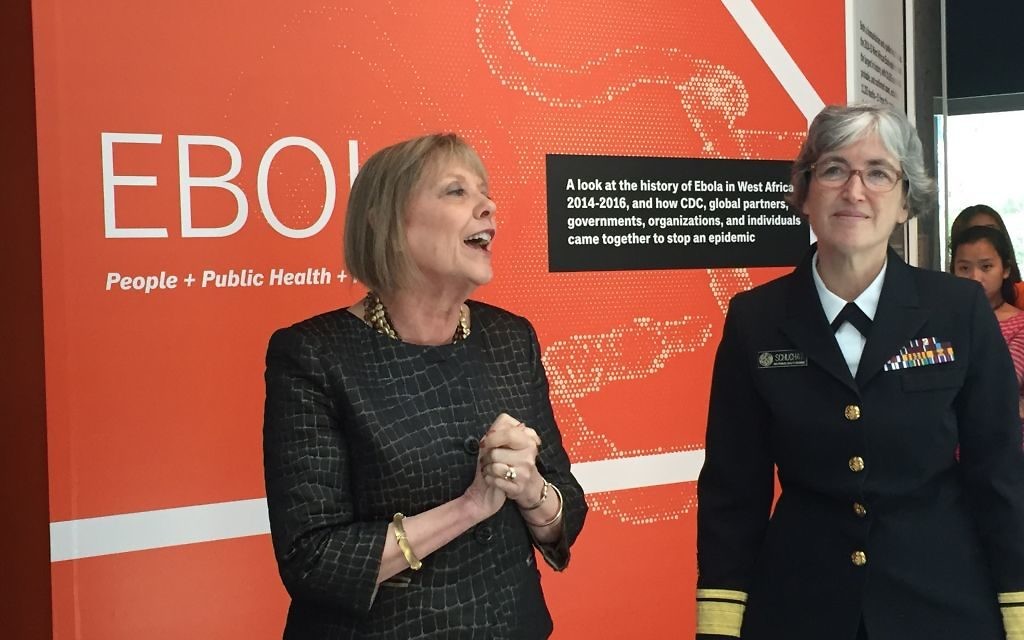CDC Exhibit Marks Loss, Heroics of Ebola Battle
More than 300 donated photos and artifacts portray the CDC's involvement in the Ebola crisis.

More than 11,000 West Africans died in the Ebola epidemic from 2014 to 2016, and several thousand Centers for Disease Control and Prevention employees responded, acting CDC Director Anne Schuchat said at the opening of the agency’s exhibit on the outbreak in Liberia, Guinea and Sierra Leone.
Visitors to the exhibit, “Ebola, People, Public Health and Political Will,” can see photos and artifacts and listen to the stories by those affected by the disease. The exhibit is scheduled to be on display at the David J. Spencer CDC Museum through May 2018. Admission and parking at the museum at 1600 Clifton Road on the CDC campus are free.
Curator Louise Shaw said the idea for the exhibit developed while the CDC was dealing with the outbreak. The show highlights people who battled the disease, public health concerns related to the crisis, and the political will of nongovernmental organizations and national groups that helped in West Africa.
Get The AJT Newsletter by email and never miss our top stories Free Sign Up
Over 300 photographs, banners, posters and lab items donated by UNICEF, the U.S. Agency for International Development and the World Health Organization are on display. The challenges of battling Ebola are shown through items such as a motorcycle uniform worn by a rider in Liberia who picked up and delivered samples to designated CDC labs.

The exhibit also features a nucleic acid extractor that processed 96 Ebola samples at a time in 30 minutes, as well as white crosses crafted to mark victims’ graves.
“Each of us who directly or indirectly was involved in the epidemic has really been touched by this experience and has changed, and we trust that as visitors walk through the museum, they will also be affected,” Schuchat said. “The world has learned a lot from this epidemic, and it is our hope that we never face such a devastating problem again.”
The exhibit begins with a brief history of Ebola, a virus that emerged in 1976, and includes the ecological impacts, early detection, and resources provided by the CDC to collect samples and assist Africans with safe burials.
“Putting on the exhibit was a team effort,” Shaw said. “We worked with so many contributors, award-winning photojournalists and designers, as well as individuals who visited West Africa.” The CDC also reached out to responders on the ground to request additional material.
The exhibit includes a display in the mezzanine depicting the spread of Ebola to Lagos, Nigeria, with 19 cases and nine deaths, and follows the story to Atlanta, where two patients were transferred to Emory for treatment.
Innovations in research, vaccine trials and lessons learned conclude the exhibit, with an emphasis on the importance of public health and preparedness.
“This has been a historic response for the CDC,” Schuchat said. “We remember those who lost their lives, the impact the experience had on our staff in Atlanta, as well as the huge tragedy for West Africa.”
CDC epidemiologist Valerie Bampoe witnessed the Ebola outbreak in Sierra Leone after being assigned to Magazine Wharf near Freetown. By the time she arrived, a cluster had begun to spread throughout the slum.
“Everything was scary, and there was a lot happening at the same time, but the community of partners and locals made it easy to deal with everyday stresses,” Bampoe said.
Over 42 days, Bampoe and her teammates were asked to monitor Ebola and prevent it from spreading until a baby’s death created further setbacks.
“I didn’t understand the magnitude of the problem until I got there. Seeing people die and witnessing communities battered repeatedly was a lot to deal with,” Bampoe said as she held back tears. “However, I left more mature and am grateful to have had the privilege of helping others. I am glad this exhibit will provide visitors a glimpse of what we lived through. It means that we were successful and accomplished what we were sent out to do.”
Bampoe, who is from Ghana, said, “It was my responsibility to help those in need as a CDC employee and as a West African.”





comments